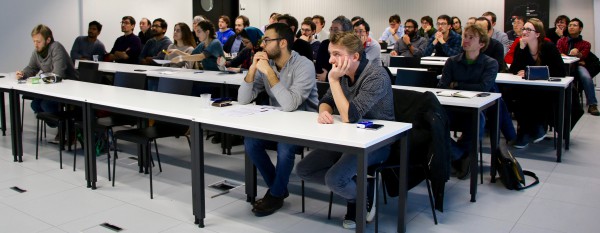MARVEL Junior Seminar — January 2019
The MARVEL Junior Seminars aim at intensifying interactions between the MARVEL Junior scientists belonging to different research groups located at EPFL. The EPFL community interested in MARVEL research topics is very welcome to attend. We believe that these events will be central for establishing a vibrant community.
Each seminar consists of two presentations of 25 minutes each, allowing to present on a scientific question in depth, followed by time for discussion. The discussion is facilitated and timed by the chair.
Pizza is served at 11:45 in the MED hall (floor 0), and after the seminar at 13:30 you are cordially invited for coffee and dessert to continue discussion with the speakers.

MARVEL Junior Seminar Organizing Committee — Francesco Ambrosio, Davide Campi, Edgar Engel, Gloria Capano, Michele Pizzochero, Kun-Han Lin, Francesco Maresca and Patrick Mayor
Check the list of the next MARVEL Junior Seminars here.
Abstract — Machine learning potentials for liquid alkanes
M. Veit, S. K. Jain, S. Bonakala, I. Rudra, D. Hohl, and G. Csányi
COSMO, IMX, STI, EPFL
The reliable prediction of the macroscopic properties of molecular liquids requires potential energy surface (PES) models that are not only accurate, but computationally efficient enough to handle large systems and reach long time scales typically inaccessible to explicit quantum-mechanical methods. This work introduces a new approach to the systematic approximation of the first-principles PES of a molecular liquid using the GAP machine learning method [A. Bartók, M. Payne, R. Kondor, and G. Csányi, Phys. Rev. Lett. 104, 136403 (2010)]. By applying machine learning to separately approximate each physical component of the interaction energy in a full many-body framework and with high and controllable accuracy, we can simulate the liquid accurately across a wide range of temperatures and pressures (with the inclusion of quantum nuclear effects) while gaining physical insight into the inner workings of the fluid. Following the recent success of this approach on predicting the equation of state of compressed fluid methane [M. Veit, S. K. Jain, S. Bonakala, I. Rudra, D. Hohl, and G. Csányi, arXiv:1810.10475], I will discuss how this approach can be extended to other molecular liquids with the help of emerging techniques in machine learning potential development, and how these ideas can be applied to other important molecular materials.
Abstract — Intrinsic ductility as a precursor to ductile fracture
P. Andric, W. Curtin
LAMMM, IGM, STI, EPFL
A crystalline material is intrinsically ductile under Mode I loading if an atomically sharp crack emits dislocation(s) and blunts rather than propagating and reaming sharp. A sharp crack in loaded material emits dislocation if the critical stress intensity factor for dislocation emission KIe is smaller than the critical stress intensity factor for Griffith cleavage KIc. Intrinsic ductility is usually estimated by the Rice theory where KIe depends on the unstable stacking fault energy. Atomistic simulations showed this theory to be reasonable, but not highly accurate in predicting KIe. An analysis of the energy change where the actual nucleation takes place reveals that the emission in Mode I is always accompanied by the surface step creation, a feature absent in the Rice theory. Here we present a new theory for dislocation emission, based on the mechanical instability at the crack-tip, which naturally includes for the step creation. Similar analysis, applied for predicting the second partial dislocation emission in fcc metals, explains why atomistic simulations always show twinning rather than full dislocation emission at T=0K. The new theory is quantitatively validated against molecular statics simulations across a wide set of materials described with various pair-potentials, and EAM potentials.
Low-volume newsletters, targeted to the scientific and industrial communities.
Subscribe to our newsletter